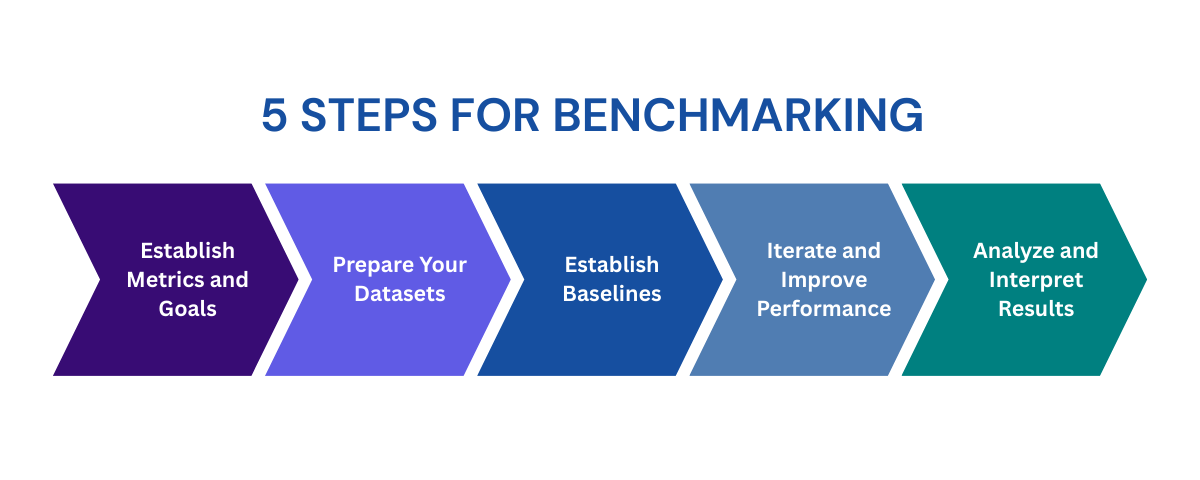At Predictive Systems Inc., we know that AI benchmarking is essential for aligning your AI solutions with real-world business goals. It’s one of the most critical—but often overlooked—parts of any AI project. A clear, structured benchmarking process helps teams move beyond guesswork, providing measurable insight into whether an AI system is actually performing as intended.
AI isn’t a “one-and-done” deployment—it’s an iterative journey that requires continuous evaluation and refinement. That’s why we’ve developed a streamlined, five-step approach to AI benchmarking—one we consistently apply to help our clients get tangible, lasting results.

1. Establish Metrics and Goals
- Clarify Objectives: Begin by identifying the specific business outcomes you need from your AI system. Are you optimizing for accuracy, efficiency, or user satisfaction?
- Survey Existing Tests: Investigate standardized benchmarks in your domain. For text generation, you might track perplexity and semantic similarity; for document extraction or classification, focus on accuracy and F1 scores.
- Define “Good Performance”: What does success look like for your use case? In highly regulated domains like healthcare, an acceptable standard might be 95% or higher; in marketing, 80–90% could be enough to guide decisions.
Why It Matters: Having a clear target keeps you (and your stakeholders) focused on what “good” really means for your business. Without it, you’re shooting in the dark and can easily chase the wrong metrics.
2. Prepare Your Datasets
- Gather Enough Samples: Aim for a robust test dataset—100 samples is a common starting point, but the actual number depends on industry and use-case complexity.
- Think Like an End User: If your model processes real-world documents, ensure a diverse range of document types. You want to reflect the data your system will see in production.
Why It Matters: High-quality, representative data is crucial for accurate insights. If your dataset doesn’t mirror real-world conditions, the performance metrics won’t tell the real story.
3. Establish Baselines
- Get Initial Performance: Run your model against the curated dataset to obtain an initial accuracy or performance score (e.g., 60%).
- Set Your Benchmark: This baseline becomes the performance threshold to improve upon. It’s your “starting line” in the race toward project goals.
Why It Matters: You can’t measure improvement without knowing where you started. A baseline keeps your AI project grounded in reality.
4. Iterate and Improve Performance
- Analyze Results: Diagnose error patterns and look for potential enhancements. Is your system repeatedly missing specific data categories?
- Fine-Tune Models: Tweak parameters, add more data, or experiment with feature optimization until you see performance inching closer to your target.
- Repeat: AI benchmarking isn’t a one-time affair. Continue refining until you hit—or exceed—your original objectives.
Why It Matters: AI models can degrade over time or fail under new conditions. Iteration ensures your system stays relevant and high-performing.
5. Analyze and Interpret Results
- Visualize Performance: Use charts and dashboards to make complex data both accessible and actionable for stakeholders.
- Highlight Business Impact: Translate your findings into ROI, cost savings, or productivity gains—whatever matters most in your context.
Why It Matters: Reporting isn’t just about the numbers—it’s about telling a story that drives decision-making and demonstrates the real value of your AI investment.
Moving Forward with Confidence
A solid AI benchmarking process—starting from clear goals and metrics, all the way to analysis and iteration—lays the foundation for responsible, high-impact AI deployment. At PSI, we’ve helped organizations across industries unlock measurable value through structured, data-driven AI development.
If your team is building or scaling AI solutions, we’re here to help you benchmark smarter, improve faster, and deploy with confidence. Let’s talk about how we can support your next move.


